1. Tarot offers an alternative to language (and a bridge to get there)
My whole life I have been a student and teacher of language. Words form the bowls or other containers that collect the “broth” of our experience, collecting, containing, and giving it shape.
There is, however, an end to words. Not necessarily to their power, but to our mastery of them. We have all experienced reaching the end of our words, but not the fullness of what we are trying to shape or express.
When I found the tarot at age 36, I was already adept at managing (and often getting around) these limitations, but when I began to understand the images, and how each deck’s iteration of the same card was something of a visual synonym, I began to think visually for the first time in my life.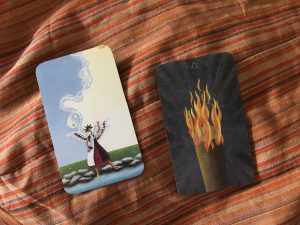
I experienced the new (to me) sensation of being able to skip the words for now, and interact with the thoughts and feelings that – like a mote on the edge of sight – chased away from the direct capture of words.
After a traumatic situation, I was able to sit (even for the barest moment) with two images and feel the same relief I’d previously achieved with a half-hour of journaling.
2. Tarot gives you a chance to exercise an underutilized part of the brain
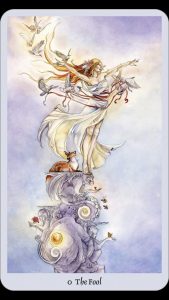 Our everyday world calls on us not only to focus on language, but also on the concrete and time-bound. All those things that have been labeled “left-brained.”
Our everyday world calls on us not only to focus on language, but also on the concrete and time-bound. All those things that have been labeled “left-brained.”
Tarot offers a rest to that part of our processing, and offers a challenge to the less-often exercised “right-brain” strategies of visualization, storytelling, and abstract connection.
Odd are good this will tire you at first. This is not a flaw in you or a malevolence in the “energy” of the cards. This is basic muscle building, and it will contribute to increasing overall mental strength and aptitude.
3. Tarot lets you practice paying attention
Functioning strongly on the principle of synchronicity, tarot has been described as a sort of storytelling inkblot test.
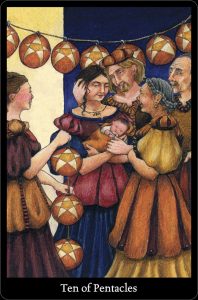 It invites comparison and connections between what is happening in our lives – whether internally or externally – and the images or archetypes of the cards randomly dealt from the deck of 78.
It invites comparison and connections between what is happening in our lives – whether internally or externally – and the images or archetypes of the cards randomly dealt from the deck of 78.
Our minds are meaning-making machines, and the connections (meaning) we are able to make can contribute to the aura of awe or mysticism that people build up around the cards. It is a reminder of how much (and what) we do and don’t pay attention to any any moment.
Which isn’t a problem, by the way: all of us have experienced those times when our brains were so busy it was difficult to focus on what we needed to focus on.
The only trouble (if there is any) is that this attention is automatic, and roughly survival-based, so without practice it can be hard to shift focus to things that have gone unnoticed till now.
4. Tarot teaches attention
With its reliance on synchronicity, tarot can teach us – through simple exposure opening our eyes – to pay attention and notice connections and patterns in overlapping areas of our lives.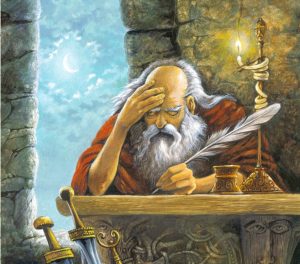
One of the things I study is power dynamics – where and how various people and groups wield and yield the power that is seen as theirs. As a result this is one lens through which I observe tarot and (by turn) a way that tarot informs my observations about the world. When thinking about ways that power can grow and be used rightly, I tied a model of the Court Cards to these [I looking forward to writing more about them later. It’s a bit specialized].
As time has gone on it’s provided a bridge to language, and a way to see and understand different ways of interacting with power. Something largely intangible and previously hard to notice.
The court cards themselves have historically been tricky to interpret, and treating (perhaps this is “reverse engineering”?) them this way has added clarity to my readings.
5. Tarot provides an example of, and a place to practice, process-orientation over goal-orientation
One of the toughest things I’ve had set in front of me in the last year is how our culture — our, schooling, stories, upbringing, even our way of “doing art” — is focused on the goal – the outcome, objective, endpoint – sometimes at the expense of the path or process toward that goal.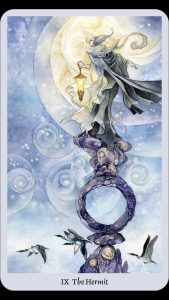
That is, as a culture we tend to value the product (the end, the goal) over the process of reaching it.
The process itself might as well be invisible with this mindset, and the majority of our attention is spent on the results.
Our language summarizes this in the familiar phrase, The ends justify the means.
Since our stories – and education and upbringing – often do resist this natural conclusion, I think there is hope for a change in focus, but there is little outside of us (or outside of a focused shift) that will support this transformation of values.
Tarot, in its lack of (fixed) 1-to-1 correlations, its anti-mathematical conclusions (despite its logic of form), invites a slowing and a comparison of components that highlight the path along with the conclusion.
The Point
Not everyone needs to study tarot, any more than everyone needs to learn how to make bread. It is made up of (and adds to) so many areas of life that we may or may not be aware of already – which means we probably have some methods already in place.
What I know from my own experience is that tarot has a reputation that is strong enough to put off people who might otherwise benefit from it a great deal.
If you are a person who does best processing externally (talking, journaling, facebooking — that’s a thing, I know it), you may find tarot is a useful tool for your toolbox.
And for people who are learning how to listen to – and reconnect with – their inner voice, their intuition, even the messages their body has been sending (this is another element tied up in intuition) this is a practical application of tarot that doesn’t require investing in mysticism, astrology, or “woo-woo” of any sort. (Assuming that’s what’s been keeping you away till now.)
It’s a tool; paper and ink (or pixels of color) and in my experience well worth the investment to learn.
~ ~ ~
Images used in this post are from the following decks:
- Sun and Moon Tarot
- Shadowscapes Tarot
- Anna K Tarot
- Druid Craft Tarot